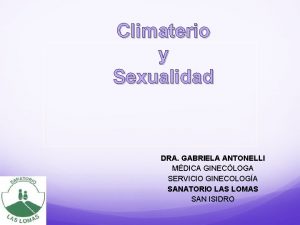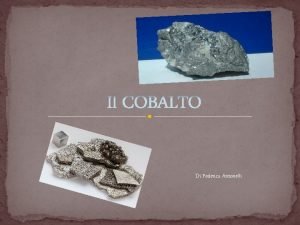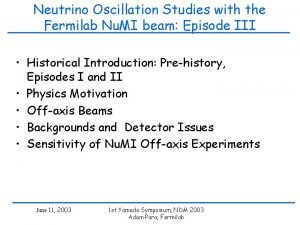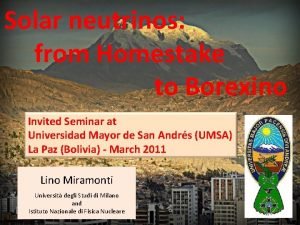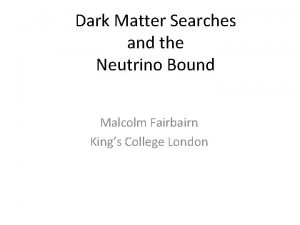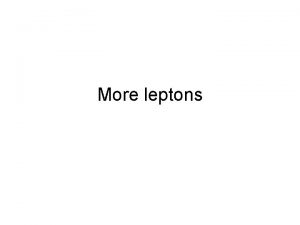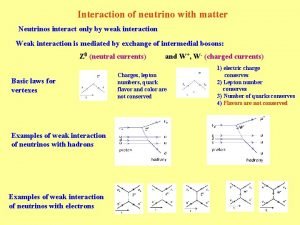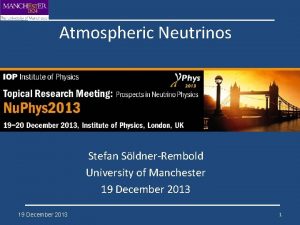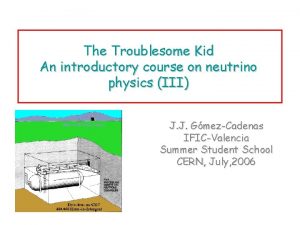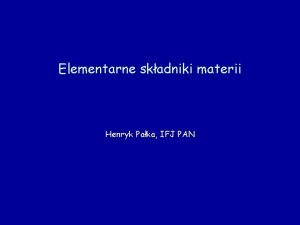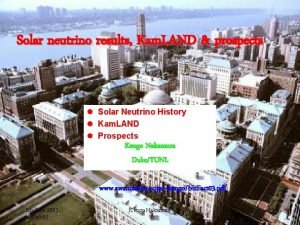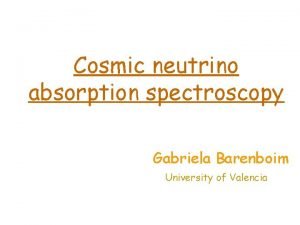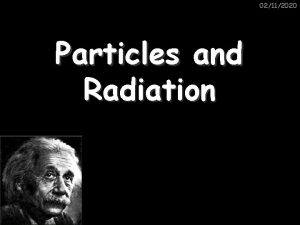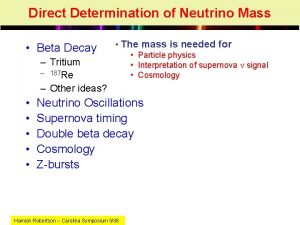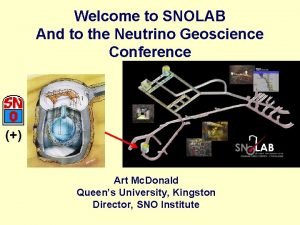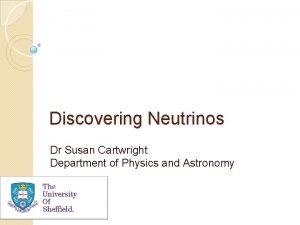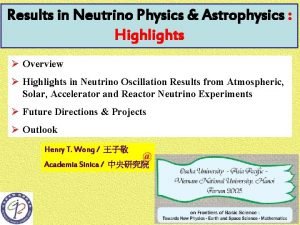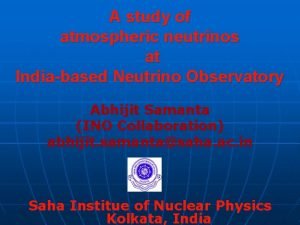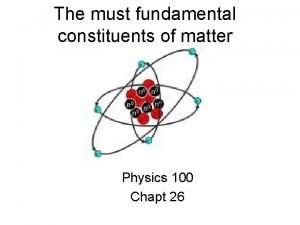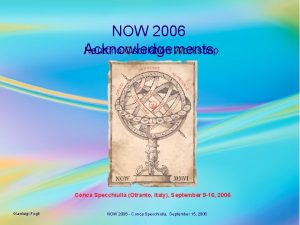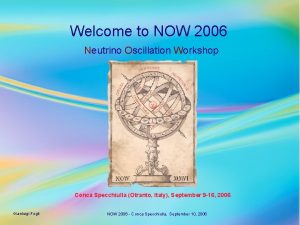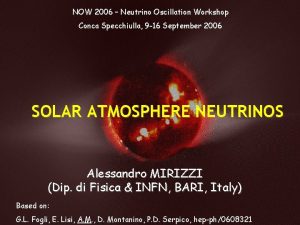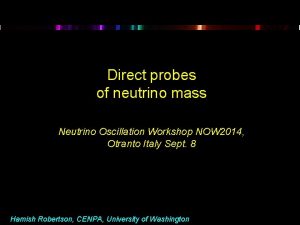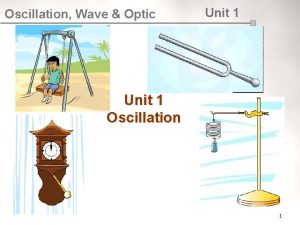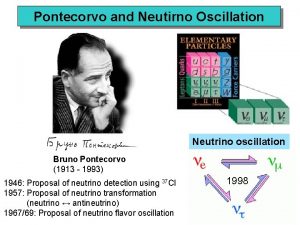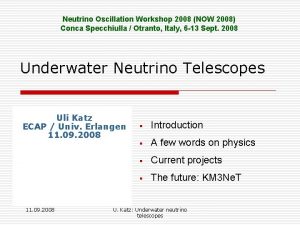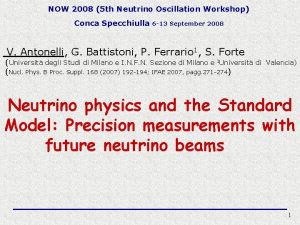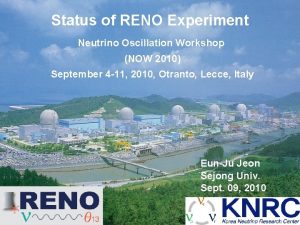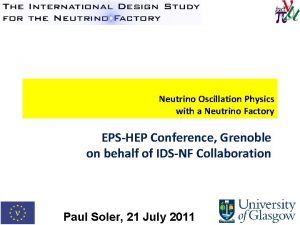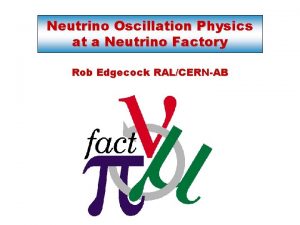NOW 2006 Neutrino Oscillation Workshop V Antonelli G


















- Slides: 18

NOW 2006 – Neutrino Oscillation Workshop V. Antonelli, G. Battistoni, P. Ferrario 1, S. Forte (Università degli Studi di Milano e I. N. F. N. Sezione di Milano and 1 University of Valencia) Standard Model tests with high intensity neutrino beams 1

Standard Model and neutrino role • ’ 60 s and ’ 70 s: 1 st experimental confirmations • Since ’ 80 s: precision tests: LEP and SLC • LEP: high energies e. w. and strong measurements • Neutrino relevance: • Neutrino beams at Gargamelle 1973 Neutral currents discovery • Interact only weakly possibility to measure Weinberg angle

WEINBERG ANGLE Theory of electroweak unification Glashow-Weinberg-Salam (1967) SU(2) x U(1) simmetry invariance weak and e. m. forces mixed coupling SU(2) g U(1) g’ 3

Neutrino physics: present status see for instance: PRD 67 (2003) 013006; PRD 69 (2004)013005; NPB (Proc. Suppl. )143 (2005)483; Progr. Part. Nucl. Phys. 57(2006)742 and 71; hep-ph/0606060 • Neutrino ( ) known since many years, but many of its properties are still poorly known • Last years very relevant results: massive and oscillating particles. Proofs from: solar (mainly Super. Kamiokande and SNO), atmospheric (SK) and reactor (Kam. LAND) neutrinos; accelerators (K 2 K, LSND? ) - At least m 2 , hence 3 mass eigenstates: m 212 : = m 22 - m 12 = 7± 1∙ 10 -5 e. V 2 : solar and from reactor (LMA solution) m 223 : = |m 32 - m 22| = 2. 0± 0. 4 ∙ 10 -3 e. V 2 : atmosferic and K 2 K - Maximal Mixing in the sector 2 -3 : tan 2 23 =1 ; combining KL and solar data: tan 2 12 = 0. 45± 0. 08 - Upper limits (from CHOOZ and Palo Verde) on mixing 1 -3: 13< 14° . . however 4

Open Problems in Neutrino Physics • Despite the relevant recent results, Still many open problems - Nature of neutrino (Dirac o Majorana) - Absolute value and hierarchy of masses (direct, inverse or quasi-degenere) - Exact determination of mixing parameters: 13=0 or 13 ≠ 0 - Search for CP violation 5

Future of neutrino physics (from accelerators) • 1 st phase: Very long baselines (MINOS, Cern/G. Sasso) and Double Chooz partial improvement of 13 ; No leptonic CP violation (important for matter-antimatter asimmetry) • Superbeams (T 2 K, NO A); • beam luminosity increase: 13 precise measurement and/or CP violation search -T 2 K (Japan, 2009): beam from JParc to Super. K (L=295 Km) -No A (USA): use the beam of Nu. MI at FNAL, detector at about 1000 Km • Neutrino factories and/or beta beams Neutrino factories: from the decay of muons in accumulation rings ( ) Beta beams: beams from decays Example: ; and 18 Ne for beams 6

T 2 K • Neutrino beam from protosinchrotron of 50 Ge. V, 7 MW • Off-axis beam to Super. Kamiokande (L = 295 Km). spring 2009 Begins • Main goals: - sin 2 13 measurement with sensitivity 20 times better than Chooz - Measurement of m 232 and sin 2 23 (atmosferic parameters) at 1 -2% ( disappearance) - search for sterile (weak currents disappearance) - Tests of Standard Model parameters: low energy measurements, different from LEP; eventual possibility of signals of new physics 7

8

Beta-Beams PRO • Only 1 flavor in the beam • Well known and determined energy (kinematics well known and nucleon recoil negligible) • Beams well collimated and with value of ( /ECM) higher than factories Proposals: - Cern- Frejus (L about 130 Km; ‘‘low’’ beam E) - Higher E beams and longer baselines (Cern-G. Sasso/Canarie) • proposed for neutrino physics, but useful also to study Standard Model ? • Analysis already available for neutrino factories Interesting to extend it to beta-beams 9

• Differential cross sections Weak interaction Lagrangian • Neutral current • Charged current 10

Neutral current scattering amplitudes FORM FACTORS introduction 11

Weinberg angle determination • 6 cross sections: neutrino (antineutrino) current on proton (neutron) and neutrino (antineutrino) charged currents • Fixing the value of electric form factors there are 6 parameters left: Weinberg angle and 5 form factors (G p M, G n M , G S S M , G A) • Analitical study: - search for cross section combinations ( - asymmetries, etc. ) to isolate Weinberg angle dependance; - ‘‘forward’’ approximation of form factors We cannot ignore ‘‘strange’’ terms and the forward approximation is not enough 12

Direct analytical solution SYSTEM of 6 equations coupled 2 by 2 • The equation for Weinberg angle can be solved analitically in terms of measurable quantities A, B, C, D, E, F: cross section combinations; y =EP/E kinematical variable of elastic scattering 13

Numerical study • From data analysis simultaneous fit of the values of Weinberg angle and hadronic form factors • In the experimental situation not possible to distinguish the neutral current on neutron from 6 to 4 cross sections loss of information. • Example of analysis: fix all the other form factors to their S central value and determine simultaneously sin 2 W ; G A (Q 2) G S A known with very bad accuracy (about 30% error), but cross sections weekly dependent on GSA. Weinberg angle determination still possible 14

Experimental requirements • It is fundamental to select QE scattering from other reactions: low energy • Neutral currents must be identified: only recoiling proton can me measured: no NC on neutron. . . • Different Q 2 bins should be investigated: kinematic reconstruction Main Obstacles: • reinteractions and Fermi motions in the nucleus: reactions different from QE can mimick QE, kinematics is in general modified, additional low energy protons are produced in the nucleus

A few examples • Nevents = ∫ d /dy Nscatt dy with: y = Ep/E /(cm 2 yr) Nscatt= n° protons (neutrons) in the detector 6 1032/kton • Elastic and quasi elastic cross sections: optimal region around 1 Ge. V (ex. T 2 K) • Geometric factor: flux increase from far to near detector 16

Detector alternatives 1) Water Cherenkov: Pro: there is the possibility of assembling a very large mass (some MTon) Con: the Cherenkov threshold prevents the detection of recoiling protons with p<1 Ge. V. 2) Liquid Argon TPC Pro: in principle p down to 50 Me. V can be identified. Con: Difficult to assemble a large mass; nuclear reinteractions in Ar are more important than in water For p > 300 Me. V Q 2 > 0. 1 Ge. V 2 , about 75% of the events surviving. Measurements at near detector already competive with detector below kton ( 500 ton to reach per mille accuracy) Interesting possibility mainly for superbeams

CONCLUSIONS • Standard Model: theory tested with high accuracy and working very well up to the electroweak scale • Useful to improve parameters knowledge at medium-low energies. • Role of neutrino physics and future experiments with high intensity beams • Neutrino (antineutrino) nucleon interaction: dependence from Weinberg angle and hadronic form factors • Analitical study of the problem and estimate of the accuracy in sin 2 W determination • Numerical analysis of the problem • Examples: beams and superbeams potentiality Measurements realistic with present Icarus technology • Measurament at energies low with respect to LEP is interesting to verify theory consistency and/or eventual signals of physics beyond S. M. 18
